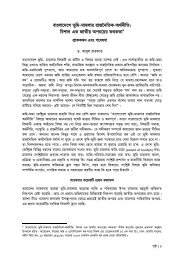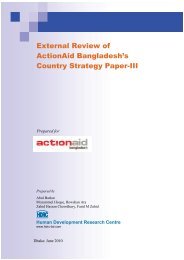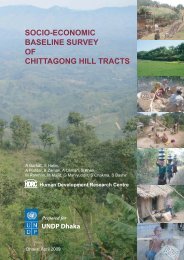08. Costing Essential Services Package An Issue Paper
08. Costing Essential Services Package An Issue Paper
08. Costing Essential Services Package An Issue Paper
Create successful ePaper yourself
Turn your PDF publications into a flip-book with our unique Google optimized e-Paper software.
<strong>Costing</strong> <strong>Essential</strong> <strong>Services</strong> <strong>Package</strong>: <strong>An</strong> <strong>Issue</strong> <strong>Paper</strong> 4<br />
Although step 1 shows two major activities, namely review of available literature on the subject<br />
and one-to-one discussion with relevant persons, these activities were not performed, strictly<br />
speaking, simultaneously (as envisaged in the original plan). All materials and studies related to<br />
the ESP costing were reviewed first, using a checklist for content analysis. The checklist<br />
included the major issues in line with the objective of the review process. In this process, in<br />
addition to the desk research, in-house brainstorming sessions among the consultants were<br />
performed to share review outcomes, ideas and to identify salient issues and subjects to be<br />
discussed later on with each individual in the list of “persons to be discussed”. Then a separate<br />
checklist was prepared to guide our discussion in the one-to-one session with 35 persons. All<br />
these 35 persons in the list were officially informed well ahead of time about the purpose of the<br />
undertaking (through an introductory letter by Mr. Syed Shamim Ahsan, and another letter from<br />
the Team Leader). Also, in order to facilitate the discussion and make the one-to-one session<br />
productive, a two-pages write up titled “Reflections on ESP <strong>Costing</strong>” (explaining the purpose<br />
and brief content of the existing literature) was sent to all 35 interviewees along with the above<br />
two letters.<br />
In line with the objectives of this undertaking, the accompanying <strong>Issue</strong> <strong>Paper</strong> presents the<br />
following (in order of sequence by sections):<br />
1. A methodological introduction on <strong>Costing</strong> ESP: What to cost, how to cost and the cost<br />
components. Since costing is a technical subject, the purpose here are two-fold – to provide<br />
information about the levels and sub-levels of HPSP for which cost has been (need to be)<br />
estimated (in order to avoid misinterpretation the ‘terms’ used should be same as in the<br />
HPSP document 2> ); and to acquaint the non-technical (non-economist/accountants) persons<br />
about the technical concepts, definitions and classifications which are necessary in any<br />
costing exercise.<br />
2. Results of desk research of the costing ESP-related documents, which include the major<br />
ones conducted by PPC and HEU, and some other studies pertaining to the major areas of<br />
ESP.<br />
3. Outcomes of one-to-one discussion with the relevant persons, which include, among others,<br />
the concerns raised and suggestions provided by each person met in the process.<br />
4. Raising of issues to be deliberated upon and discussed by the workshop participants aiming<br />
at improvement upon the ESP <strong>Costing</strong>.<br />
4. Methodological Introduction on <strong>Costing</strong> <strong>Essential</strong> <strong>Services</strong><br />
<strong>Package</strong> (ESP): What to Cost, How to Cost, and Cost Components<br />
What to cost? Health and Population Sector Program (HPSP) comprises of eight major<br />
components, namely <strong>Essential</strong> <strong>Services</strong> <strong>Package</strong>s (ESP), Reorganization of Service Delivery<br />
(RSD), Integrated Support <strong>Services</strong> (ISS), Hospital Level <strong>Services</strong> (HLS), Sector Wide<br />
Management (SWM), Policy-Regulation-NGO-Private Sector (PRNP), Other Public Health<br />
<strong>Services</strong> (OPHS), Other Health and Nutrition <strong>Services</strong> (OHNS) (Figure 2). Although ESP is one<br />
of the 8 major components of HPSP, part of all seven other components (other than ESP,<br />
known as non-ESP) are directly or indirectly related to ESP. Thus, expenditure for ESP is a sum<br />
total of ESP service delivery and the relevant portions of ESP in the other seven components.<br />
2> For example, some people denote Reproductive Health Care (RHC) as a component of ESP. According to HPSP, ESP is a component of HPSP<br />
and RHC is one of the five major sub-areas under ESP (GoB 1998a: 18-68).






